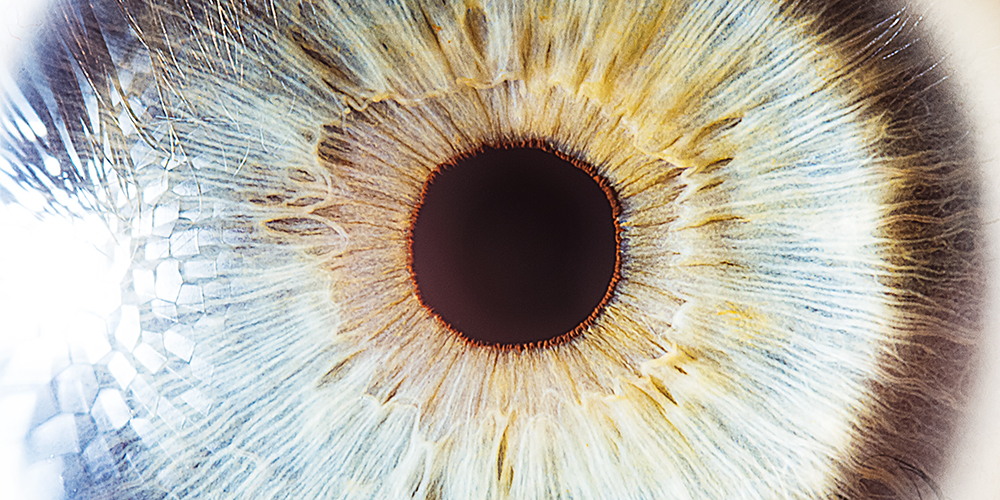Advancing vision research.
Text: Botond Roska und Hendrik Scholl
The development of new treatments for patients suffering from vision impairments worldwide is the focus of a group of research teams at the new Institute for Molecular and Clinical Ophthalmology Basel (IOB), which is affiliated with the University of Basel, helping to enhance the university’s international reputation.
Vision is precious. In a survey conducted in the United States, asking people what their worst clinical condition would be, blindness topped the list.
Globally, the prevalence of eye diseases continues to rise. A total of 36 million people are blind, and more than 1 billion people experience a significant degree of vision impairment. Many conditions that lead to blindness cannot be treated effectively, or even at all.
The eye is particularly suited for diagnostic and therapeutic exploration owing to its easy accessibility, small volume, internal compartmentalization, stable cell populations, optical transparency for evaluation, and reduced adverse responses to injected therapeutics thanks to the favorable immune situation.
Nevertheless, innovation in ophthalmology has been frustratingly slow. Basic researchers rarely understand the unmet medical need, because they lack the experience of patient feedback. Clinicians are often not sufficiently aware of the latest advances in fundamental research.
A medical dream
The new Institute of Molecular and Clinical Ophthalmology Basel (IOB) was created in 2017 to bridge this gap. At the institute, basic researchers and clinicians work hand in hand daily to develop novel therapies in ophthalmology. A key innovation compared with previous approaches is our focus on cell types rather than tissue.
Different disciplines and technologies are combined including genetics, virology, molecular biology, organoid research, electrophysiology, two-photon imaging and computational tools. Taken together, these methods enable an understanding of the structure and function of the eye and of vision at different stages of processing, as well as the mechanism of eye diseases. We can then develop innovative therapies to slow the progression of vision loss, or to restore vision when it is lost.
Most vision disorders originate in the retina. Restoring sight to the blind by retinal repair has remained the desire of medicine for centuries. Gene replacement or gene editing can, however, now slow down, stop, or even reverse vision loss. The first successful procedures have recently been reported.
The most common causes of blindness in younger people are hereditary retinal dystrophies. Stargardt disease and retinitis pigmentosa – a retinal degenerative disease caused by damage to the photoreceptors – begin to harm vision in childhood, and can lead to blindness even in early adulthood. Retinitis pigmentosa affects nearly 1.5 million people worldwide; one in 8,000 people suffers from Stargardt disease. Both conditions are the focus of translational research at IOB, that is projects that aim to translate preclinical research into practical application in hospitals quickly and efficiently.
The retina as computer
An approach known as optogenetic therapy is currently being developed, for example, to re-sensitize a degenerated retina to visible light. The expression of an optogene encoding a light-activated channel or pump in the remaining inner retinal cells makes them light sensitive, independent of the mutation causing photoreceptor cell loss. The human retina is like a powerful computer that shapes visual perception. At IOB, a computer model of the retina was built that simulates the different pathways that a signal can take through the retina. When adapted to the human retina, this model could allow the prediction of the outcome of eye diseases.
Stem cell technology allows the transformation of patient skin samples into highly organized in vitro retinas with the donor’s genetic markers. These human retinal organoids demonstrate many of the cell types that are found in a normal retina of a living human, plus they can form a primitive optic nerve. The effects of mutations on retinal cells can therefore be studied directly in a culture dish. Such organoids can also be used to develop in vitro disease models, e.g. for retinal and macular dystrophies such as Stargardt disease. Now, gene therapies can be developed that can precisely target each of the different cell types with specific vectors. New therapies could soon be tested specifically on patients’ own retinal organoids.
If gene therapies do not target specific cell types, it is possible that they will be ineffective or even harmful. Adeno-associated viral (AAV) vectors are the most promising approach for delivering gene therapy into the retina or the brain. The targeted expression to specific cell types, however, still poses challenges. Researchers at IOB have developed a library of 230 AAVs, each with a different synthetic promoter. This AAV vector library allows fast and efficient targeting of expression to neuronal and glial cell types in a variety of species. This is a milestone, both for fundamental science and for gene therapy. AAV vector libraries also allow for cell-type targeting in human retinas to be tested in vitro. This significantly increases the probability that a chosen vector will target the desired cell type in patients in vivo.
A novel “virus stamping” method has also been developed at IOB that allows the efficient study of genes. Here, individual cells in cell cultures, from brain tissue, experimental animals, and organoids can be infected with a virus – or with multiple viruses, either simultaneously or at different time points. Virus stamping allows for the examination of the role of specific genes in clearly defined cells. It is a versatile solution for fundamental biomedical research, and potentially for gene therapy.
Short-sightedness on the increase
Worldwide, and especially in Asia, short-sightedness is increasing rapidly. In some regions, up to 90% of teenagers are affected, compared with 10 to 20% in the Chinese population 60 years ago. The major problem with short-sightedness is not the need to wear glasses, but rather frequent loss of vision via resulting complications, such as myopic macular degeneration, glaucoma, or retinal detachment. Neurodegeneration of the retina such as in dry age-related macular degeneration, diabetic eye disease, retinal dystrophies, and glaucoma currently remains untreatable. In aging societies, such disorders are a leading cause of disability and loss of independent living. At IOB, research therefore also focuses on growth regulation of the eye to address myopia and to expand our understanding of glaucoma.
More articles in the current issue of UNI NOVA.



